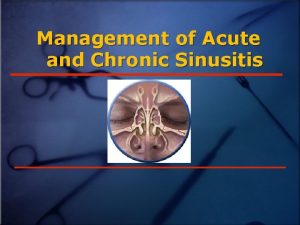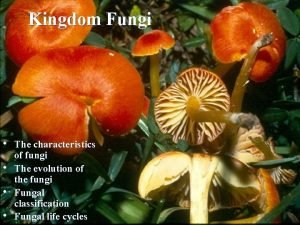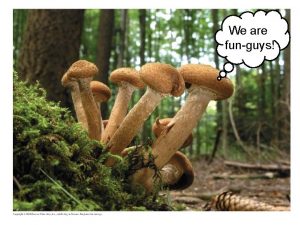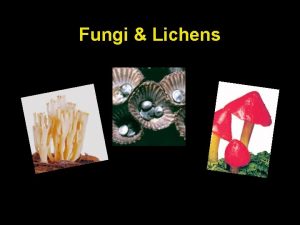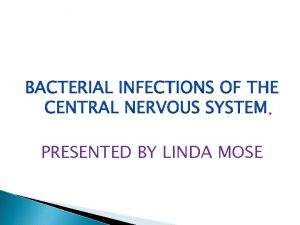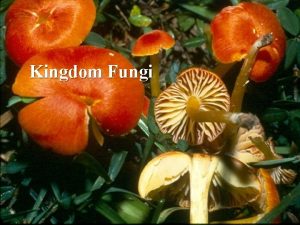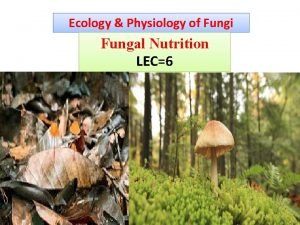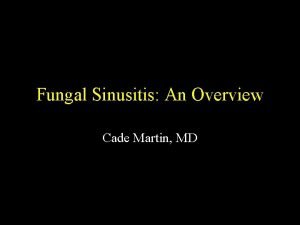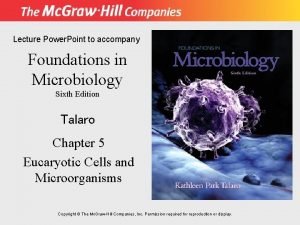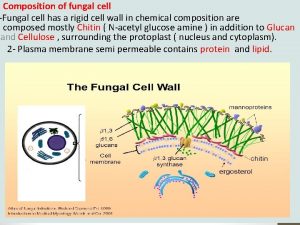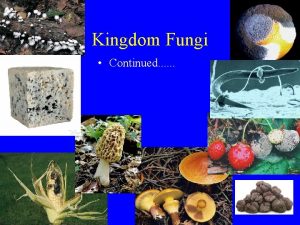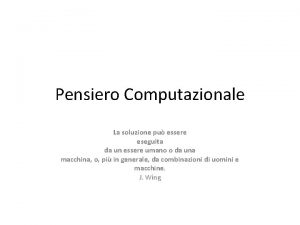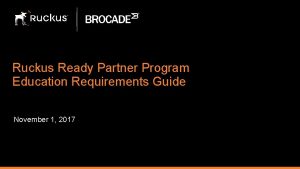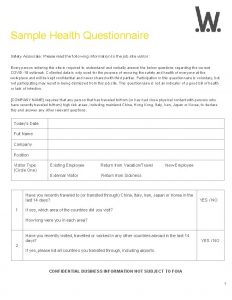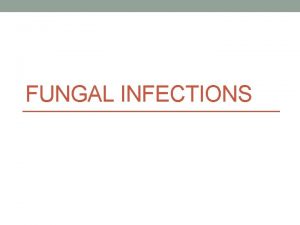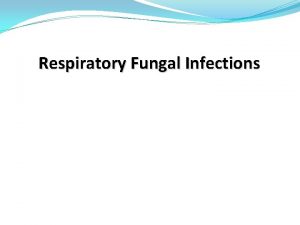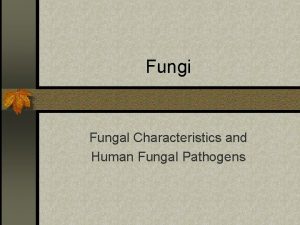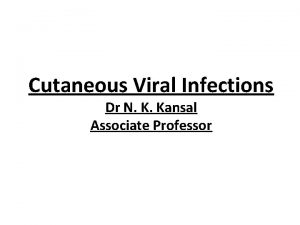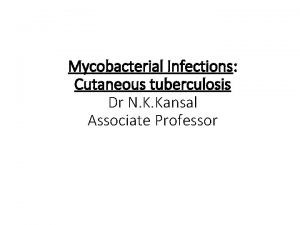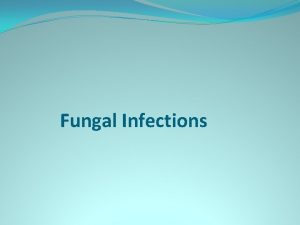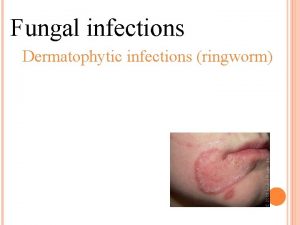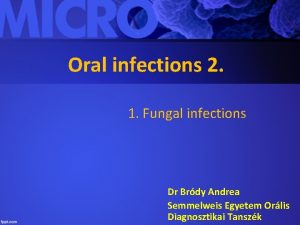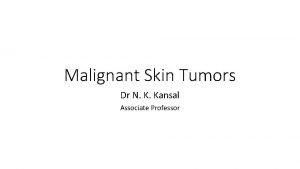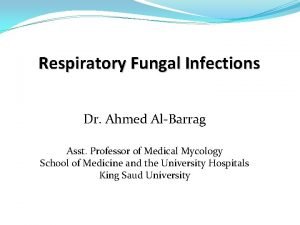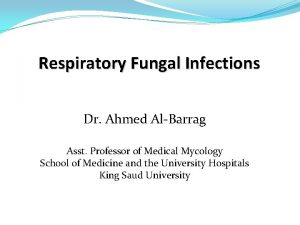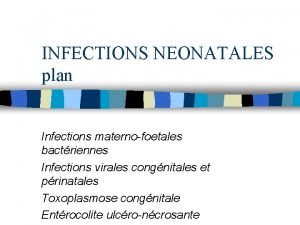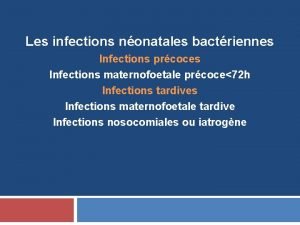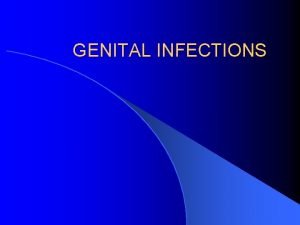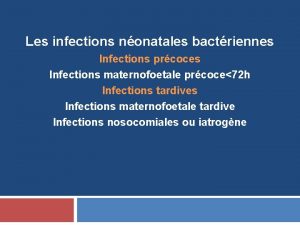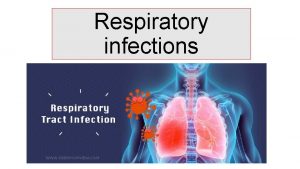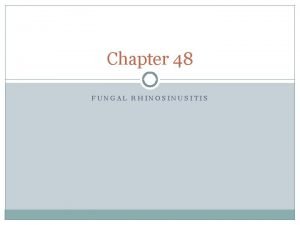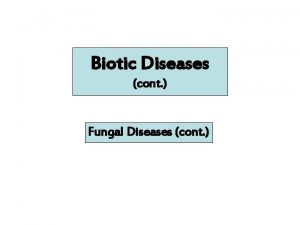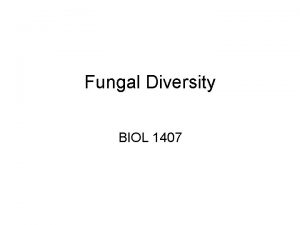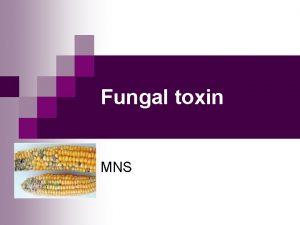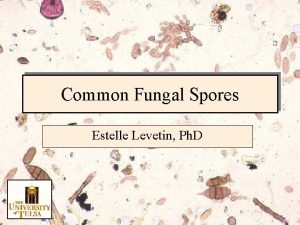Fungal infections Dr N K Kansal Associate Professor









































- Slides: 41

Fungal infections Dr N. K. Kansal Associate Professor

Natural defence against fungi Ø Fatty acid content of the skin Ø p. H of the skin, mucosal surfaces and body fluids Ø Epidermal turnover Ø Normal flora (bacterial; fungal)

Predisposing factors Ø Climate: Tropical, profuse sweating Ø Manual labor population Ø Lower socioeconomic status Ø Friction with clothes, synthetic innerwear Ø Malnourishment Ø Immunosuppressed patients: HIV infection/AIDS, congenital immunodeficiencies, patients on corticosteroids, immunosuppressive drugs (posttransplant), diabetes mellitus

Fungal infections: Classification v Superficial cutaneous: Surface infections e. g. , Pityriasis versicolor, Dermatophytosis, Candidiasis, Tinea nigra, Piedra v Subcutaneous: Mycetoma, Chromoblastomycosis, Sporotrichosis, Phaeohyphomycosis v Systemic: (opportunistic infection) Histoplasmosis, Candidiasis, Zygomycosis

Pityriasis versicolor Etiologic agent: Malassezia furfur (formerly: Pityrosporum) Clinical features: Ø Common among youth Ø Genetic predisposition, familial occurrence Ø Multiple, discrete, discoloured, macules, may be fawn, brown, grey colored or hypopigmented Ø Pinhead sized to large sheets of discolouration ØSeborrheic areas, upper half of body: trunk, arms, neck, abdomen

P. versicolor : Investigations Ø Wood’s Lamp (365 nm) examination: Yellow fluorescence Ø KOH preparation: “Spaghetti and meatball” appearance Coarse mycelium, fragmented to short filaments 2 -5 micron wide, together with spherical, thick-walled yeasts 2 -8 micron in diameter, arranged in grape like fashion.

Treatment P. versicolor Topical: Ø Ketoconazole, Clotrimazole, Miconazole, Terbinafine, Selenium sulfide Oral: Ø Fluconazole 400 mg single dose Ø Ketoconazole 200 mg OD x 14 days Ø Oral griseofulvin & oral terbinafine: NOT effective. Ø Hypopigmentation will take weeks to fade Ø Scaling will disappear soon

Treatment P. versicolor ØP. versicolor recurs if predisposing factors not taken care of ØMinimizing sweat, frequent washes and control of immunosuppression causes long remission

• Treatment: Oral Itraconazole, Ketaconazole, Fluconazole or topical Ketoconazole shampoo.

Tinea nigra palmaris Etiology: Hortaea werneckii (formerly: Exophiala werneckii ) Clinical features: Asymptomatic superficial infection of palms; deeply pigmented, brown or black macular, non-scaly patches, resembling a silver nitrate stain.

• Treatment: Topical antifungals (e. g. , ketoconazole)

Black piedra ØEtiology: Piedraia hortae ØDistribution: South America and in South-East Asia ØClinical features: Hard, dark, multiple superficial nodules; firmly adherent black, gritty, hard nodules on hairs of scalp, beard, moustache or pubic area, hair may fracture easily. ØTreatment: Shaving or cutting the hair. Terbinafine

White piedra Etiology: Trichosporon beigelii Clinical features: Soft, white, grey or brown superficial nodules on hairs of the beard, moustache , pubic areas. Hair shaft weakened and breaks. Treatment: Shaving or cutting the hair. Responses to topical antifungals, azoles and allyamines have been reported but are unpredictable.

Dermatophytosis Mycology: ØThree genera: Microsporum, Trichophyton, Epidermophyton ØThey can be zoophilic, anthropophilic or geophilic. ØThrive on dead, keratinized tissue - within the stratum corneum of the epidermis, within and around the fully keratinized hair shaft, and in the nail plate and keratinized nail bed.

Dermatophytes are keratinophillic ØThe topmost layer (stratum corneum) is a sheet of non -nucleated cells (corneocytes) containing protein – keratin – stuck together forming a tough barrier Ø This barrier, when dry allows fungi to stay on the surface but stops them from piercing it Ø However, when moist, it becomes porous and sucks in the fungi like a sponge.

Dermatophytosis (Ringworm) v. Terminology: ØHead: Tinea capitis ØFace: Tinea faciei ØBeard: Tinea barbae ØTrunk/body: Tinea corporis ØGroin/gluteal folds: Tinea cruris ØPalms: Tinea manuum ØSoles: Tinea pedis ØNail: Tinea unguium

Tinea capitis Invasion of hair shaft by a dermatophyte fungus. Clinical features: ØCommon in children with poor nutrition and hygiene. Rare after puberty because sebum is fungistatic. ØWide spectrum of lesions - a few dull-grey, broken-off hairs, a little scaling to a severe, painful, inflammatory mass covering the scalp. ØPartial hair loss is common in all types; cicatricial (scarring ) alopecia can occur

Tinea capitis Endothrix and Ectothrix Term used to indicate infection of hair shaft, spores lying inside or outside hair shaft. 4 varieties: ØGray patch ØBlack dot ØFavus ØKerion (similar to a ‘boil’)

Non inflammatory Tinea capitis: Black dot/ Grey patch Ø Breakage of hair gives rise to ‘black dots’ Ø Patchy alopecia, often circular, numerous broken-off hairs, dull grey Ø Inflammation is minimal Ø Wood's lamp examination: green fluorescence (occasional non-fluorescent cases)

Tinea capitis: Kerion Inflammatory variety Painful, inflammatory boggy swelling with purulent discharge. Hairs may be matted, easily pluckable Lymphadenopathy Co-infection with bacteria is common May heal with scarring alopecia

Tinea capitis: Favus Inflammatory variety Yellowish, cup-shaped crusts (scutula) develop around a hair with the hair projecting centrally. Adjacent crusts enlarge to become confluent mass of yellow crusting. Hair may be matted Extensive patchy hair loss with cicatricial alopecia

Tinea faciei Erythematous scaly patches on the face Annular or circinate lesions and induration Itching, burning and exacerbation after sun exposure Seen often in immunocompromised adults

Tinea barbae Ringworm of the beard and moustache areas Invasion of coarse hairs Disease of the adult male Highly inflammatory, pustular folliculitis Hairs of the beard or moustache are surrounded by inflammatory papulopustules, usually with oozing or crusting, easily pluckable Persist several months

Tinea corporis Lesions of the trunk and limbs, excluding ringworm of the specialized sites such as the scalp, feet and groins etc. The fungus enters the stratum corneum and spreads centrifugally. Central clearing results once the fungi are eliminated. A second wave of centrifugal spread from the original site may occur with the formation of concentric erythematous inflammatory rings.

Tinea corporis Classical lesion: Annular patch or plaque with erythematous papulovesicles and scaling at the periphery with central clearing resembling the effects of ring worm. Polycyclic appearance in advanced infection due to incomplete fusion of multiple lesions Sites: waist, under breasts, abdomen, thighs etc.

Tinea cruris Itching Erythematous plaques, curved with well demarcated margins extending from the groin down the thighs. Scaling is variable, and occasionally mask the inflammatory changes. Vesiculation is rare

Tinea mannum Two varieties: Non inflammatory: Dry, scaly, mildly itchy Inflammatory: Vesicular, itchy

Tinea pedis Wearing of shoes and the resultant maceration Adult males commonest, children rarely Peeling, maceration and fissuring affecting the lateral toe clefts, and sometimes spreading to involve the undersurface of the toes. Two varieties: Dry, scaly, mildly itchy, extensively involved ('moccasin foot‘) Vesicular, itchy, with inflammatory reactions affecting all parts of the feet

Tinea pedis : Prevention Keeping toes dry Not walking barefoot on the floors of communal changing rooms Avoiding swimming baths. Avoid closed shoes Avoid nylon socks Use of antifungal powders

Tinea Unguium Dirty, dull, dry, pitted, ridged, split, discoloured, thick, uneven, nails with subungual hyperkeratosis Different types described depending on the site of nail involvement and its depth. Distal and lateral onychomycoses Proximal subungual onychomycoses White superficial onychomycoses Total dystrophic onychomycoses

Treatment: Ringworm Topical: Ketoconazole, Clotrimazole, Miconazole, Butenafine, Terbinafine. Vehicle: Lotions, creams, powders, gels are available.

Treatment: Tinea Oral: Griseofulvin 250 mg BD Fluconazole 150 mg weekly Ketoconazole 200 mg OD Terbinafine 250 mg OD Itraconazole 200 mg OD Duration: T. capitis - 6 weeks T. faciei - 4 weeks T. cruris - 4 weeks T. corporis - 4 -6 weeks T. manuum/pedis - 6 -8 weeks Shorter duration required for terbinafine & itraconazole

Treatment: Tinea unguium The same line of Treatment for 3 months (fingernail) to 6 months (toenails) 8% Ciclopirox olamine lotions for local application Amorolfine nail lacquer painted weekly Pulse Therapy Terbinafine: 250 mg given 1 BD x 1 week / per month Itraconazole: 200 mg given 1 BD x 1 week/month 3 pulses for fingernails, 4 pulses for toenails.

Treatment Principles Patient should be explained clearly about the predisposing factors Need for personal hygiene, proper clothing should be emphasized Selection of topical medication: Do not use ointments on areas of friction or on greasy areas Do not rub creams/ointments in groin folds Choose steroid combinations only if itch is a major complaint. Do not use antifungal creams in combination with potent steroids

Treatment Principles Dermatophytosis will take 3 -4 weeks to resolve and patient should be told about the need for complete treatment. Treat 1 week beyond apparent cure. Need for hygiene, proper clothing. Onychomycosis requires 3 -6 months of treatment. Treat 4 weeks beyond apparent cure. Temporary relief should not be mistaken for cure

Candidiasis Causative organism: Candida albicans, Candida tropicalis, Candida pseudotropicalis Sites of affection: Mucous membrane Skin Nails

Candidiasis : Mucosal Oral thrush: Creamy, curd-like, white pseudomembrane, on erythematous base Sites: Immunocompetent patient: cheeks, gums or the palate. Immunocompromised patients: affection of tongue with extension to pharynx or oesophagus; ulcerative lesions may occur. Angular cheilitis (angular stomatitis / perleche): Soreness at the angles of the mouth

Candidiasis : Mucosal Vulvovaginitis (vulvovaginal thrush): Itching and soreness with a thick, creamy white discharge Balanoposthitis: Tiny papules on the glans penis after intercourse, evolve as white pustules or vesicles and rupture. Radial fissures on glans penis in diabetics. Vulvovaginitis in conjugal partner

Candidiasis - Flexural Intertrigo: (Flexural candidiasis): Erythema and maceration in the folds; axilla, groins and webspaces. Napkin rash: Pustules, with an irregular border and satellite lesions

Candidiasis: Nail Chronic Paronychia: Swelling of the nail fold with pain and discharge of pus. Chronic, recurrent. Superadded bacterial infection Onychomycosis: Destruction of nail plate.

Treatment of candidiasis Treat predisposing factors like poor hygiene, diabetes, AIDS, conjugal infection Topical: Clotrimazole, Miconazole, Ketoconazole, Ciclopirox olamine Oral: Ketoconazole 200 mg, Itraconazole 100 -200 mg and Fluconazole 150 mg
 Promotion from associate professor to professor
Promotion from associate professor to professor Allergic fungal sinusitis treatment
Allergic fungal sinusitis treatment Milady chapter 10
Milady chapter 10 Fungal spores
Fungal spores What condition do fungal organisms favor for growth
What condition do fungal organisms favor for growth Dikaryotic fungal life cycle
Dikaryotic fungal life cycle Xenosporas
Xenosporas Clasification of fungi
Clasification of fungi Ocular histoplasmosis
Ocular histoplasmosis Csf analysis
Csf analysis Kingdom fungi cell wall
Kingdom fungi cell wall Fungal nutrition
Fungal nutrition Allergic fungal sinusitis
Allergic fungal sinusitis Fungal reproduction
Fungal reproduction Fungal cell wall
Fungal cell wall Phyla
Phyla Postpartum infections
Postpartum infections Chapter 25 sexually transmitted infections and hiv/aids
Chapter 25 sexually transmitted infections and hiv/aids Bone and joint infections
Bone and joint infections Opportunistic infections
Opportunistic infections Retroviruses and opportunistic infections
Retroviruses and opportunistic infections Ciliary escalator
Ciliary escalator Understanding the mirai botnet
Understanding the mirai botnet Cryptosporidiose
Cryptosporidiose Can methotrexate cause yeast infections
Can methotrexate cause yeast infections Genital infections
Genital infections Classification of acute gingival infections
Classification of acute gingival infections Storch infections
Storch infections Eye infections
Eye infections Opportunistic infections
Opportunistic infections Genital infections
Genital infections Storch infections
Storch infections What is incose
What is incose What is an experience assessment
What is an experience assessment Imeche associate membership
Imeche associate membership Associate consultant in capgemini
Associate consultant in capgemini برنامهxx
برنامهxx Berstoff gearbox repair
Berstoff gearbox repair Tecniche associate al pensiero computazionale
Tecniche associate al pensiero computazionale Ruckus ready partner program
Ruckus ready partner program Safety associate
Safety associate Associate director meaning
Associate director meaning

